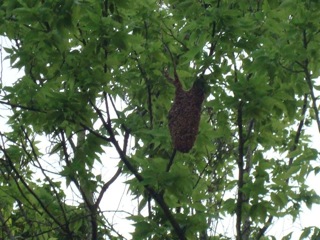After trimming trees around the house for much of the afternoon, we were taking a little iced-tea break on our deck. I began to see quite a bit of activity out in the bee yard…more than usual. It didn’t look like a swarm, but there were a lot of bees. You can see them when the sun lights them up against the dark background of the woods behind our house.
When I went to check on things, I found robbing occurring at Tomboys and Girls of Summer. There was bee frenzy going on out there. Amazons seemed far more calm. And the robbing bees were coming from the woods where I assume the swarm went to live on Saturday morning. It was pretty wild out there, and I’m kicking myself that I didn’t capture it on my camera (only a video would show the craziness and capture the impressive sound of this, though). I never think to grab my camera when I go out there. And if I do put my camera in my pocket, I forget it’s there.
Here’s what I assume is happening: I’m pretty sure the swarm with which we’ve just dealt was from Amazons because Amazons are so darn robust. And, more importantly, because we discovered a lot of queen cells in the hive when we inspected it on Saturday…a sure sign the hive is planning to swarm. So now the swarm has found a place to live, but they don’t have food stored up in their new place…they would know, however, that there’s honey near their old house. So they came back to rob their old neighbors, Tomboys and Girls of Summer…those two hives are newer and so have less strength and fewer guard bees to protect the hive. But they’ve stored up good honey already…honey the Amazon swarm clearly wants.
The robbers were not robbing Amazons nearly so much because those girls are their sisters…for real. And Amazons are a more established and stronger hive than the two new colonies and so can defend themselves better against intruders.
This morning I plan to put entrance reducers on Tomboys and Girls of Summer. I’ll also plug the holes I drilled in the brood-chamber boxes for a few days. Those holes are unnecessary openings, and plugging them will allow the guard bees to defend only one (reduced) opening.
I’m still bemoaning the loss of honey production from Amazons this year. The honey we collected on Saturday is so beautiful in their pretty jars. I’ve got them all lined up on the counter now, and they are amazingly gorgeous when the sun hits them.






